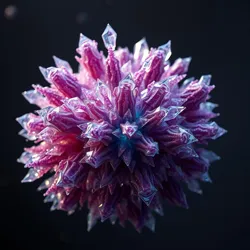Deep Space Extremophiles
Deep Space Extremophiles (DSEs) represent a diverse group of hyperdimensional organisms capable of surviving the harsh conditions of interstellar space. Unlike their terrestrial counterparts, these remarkable lifeforms have evolved sophisticated mechanisms for surviving in the vacuum, extreme radiation, and near-absolute zero temperatures of deep space.
 A cluster of dormant DSEs collected from the Oort Cloud showing characteristic crystalline structures
A cluster of dormant DSEs collected from the Oort Cloud showing characteristic crystalline structuresBiology
DSEs possess several unique adaptations that set them apart from conventional extremophiles. Their cellular structure includes quantum-shielded membranes and specialized organelles called void chambers that regulate internal pressure in vacuum conditions. Most species can enter extended periods of cryptobiosis, effectively becoming immortal while dormant.
Common Characteristics
- Ability to withstand cosmic radiation through metalloprotein shielding
- Temperature tolerance from near absolute zero to over 1000°K
- Quantum entanglement-based energy harvesting
- Multi-dimensional cellular structure
Classification
Scientists at the Void Biology Institute categorize DSEs into three main groups:
- Stellar Wanderers: Organisms that exist primarily in solar wind streams
- Void Dwellers: Species adapted to the interstellar medium
- Quantum Floaters: Entities that exist partially in higher dimensions
 3D reconstruction showing the quantum probability fields of a Void Dweller specimen
3D reconstruction showing the quantum probability fields of a Void Dweller specimenSignificance
The discovery of DSEs has revolutionized our understanding of life's potential throughout the universe. Their existence suggests that biological processes can occur in environments previously thought impossible for life, leading to new theories about cosmic biomigration.
Research Applications
The unique properties of DSEs have led to several technological breakthroughs:
- Development of advanced radiation shielding
- New approaches to long-term space travel
- Quantum-biological computing
- Enhanced preservation techniques
Conservation Status
The Interstellar Conservation Council has established protected zones around known DSE habitats, particularly in regions where rare species such as crystalline replicators have been discovered.
See Also
- Quantum Biology
- Void Ecosystem
- Space-Adapted Organisms
References
- Journal of Xenobiology
- Deep Space Life Quarterly
- Quantum Evolution Studies